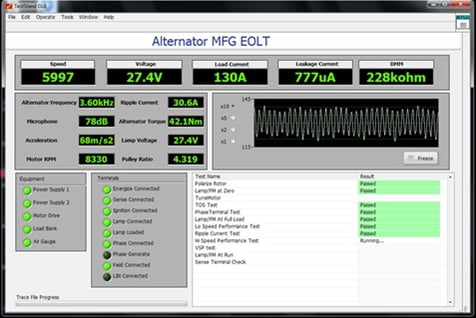+1 (317) 804-2330 | info@ballsystems.com | Blog
+1 (317) 804-2330 | info@ballsystems.com | Blog

Without first-rate data collection in place, it’s impossible to trust that your power electronics test will deliver top-quality products. Inadequate, inaccurate, or ineffective data acquisition leads to losses of critical information in both validation and in production testing. Products can get mired in the validation and verification phase. A potentially cutting-edge product solution loses out on the chance to be first to market. And the test engineer risks delivering a deficient product to the customer or consumer.
As you begin to plan your rotating electrics testing project, the test software design phase is critical to ensuring your data needs are fulfilled. The test systems we’ve developed in rotating electrics – from durability stations for new PO Motor Generator Devices to creating a custom, open-architecture alternator test system – have undergone rigorous scrutiny to ensure data integrity and quality. If you aim to be a top provider in your industry, here are the main considerations for collecting test data:
Define the timing requirements of the data you want to acquire when an event or trigger occurs – In your test system, you need the capability to isolate data around a timeframe that will help you identify failure. A test system should be able to effectively acquire data at a high-speed before and after an event and store it for review.
For instance, in our durability test station, we designed a “Flight Recorder” software  system – modeled after the black box crash data collection unit in airplanes – that captures data every 20-milliseconds over a 60-second timespan. If a failure occurs, the system will stop within 400 milliseconds and the test engineer can examine both the 30 seconds prior to DUT failure and the subsequent 30 seconds after failure. Because we understand how the DUT is supposed to operate, we can record all necessary feedback and properly qualify when the failure occurs. The result is an efficient feedback loop that delivered fast product improvement.
system – modeled after the black box crash data collection unit in airplanes – that captures data every 20-milliseconds over a 60-second timespan. If a failure occurs, the system will stop within 400 milliseconds and the test engineer can examine both the 30 seconds prior to DUT failure and the subsequent 30 seconds after failure. Because we understand how the DUT is supposed to operate, we can record all necessary feedback and properly qualify when the failure occurs. The result is an efficient feedback loop that delivered fast product improvement.
Choose the proper equipment – After you’ve defined the timing requirements of your data needs, it’s essential to choose test and data acquisition equipment that can effectively capture measurement data at the necessary rate. Without the right equipment, you will acquire erroneous data, or you may miss critical information, events, or transitions altogether. You need to ensure you are working with equipment that supports the specifications that meet your data acquisition requirements for testing.
This is where leveraging a test expert can be particularly helpful. An engineering team with experience building test systems and capturing data for a variety or products and industries will be able to evaluate your needs and make the right equipment recommendations. This way, you can rest assured that you are receiving proper values and readings from the DUT.
Identify software and hardware triggers – Software triggers tell your test equipment to start collecting and recording information based upon a pre-determined scenario. Hardware triggers occur when a specific action or event takes place. Based on this hardware trigger, a measurement needs to be taken and the equipment should react accordingly. In the design process of your test equipment, your test system provider will help you to develop these specifications. Test engineers will need to be able to understand the limitations of the DUT and the actual inputs and outputs of the device. You will need to determine the likely critical failure modes of the DUT (operating temperature, maximum and minimum current, voltage, and maximum velocity). These triggers can also be self-generated to cause failure modes. In a test environment, you may want to inject a fault to see how the DUT reacts.
Accuracy of data is essential – Getting precise data requires defined timing, signal integrity, effective equipment selection, and competent design implementation. Before your test system is developed, you want to identify critical values for sensors, digital or analog data, temperature, speed, current, sound and vibration, and ground fault readings you need. Once you define these requirements and create a test plan, you may consider a gap analysis with a test partner to ensure you haven’t overlooked critical values.
If you are ready double-check the quality of your plan or begin developing your system, contact us to help determine your testing needs and quote the right equipment to get it done.
Ball Systems designs, develops, and delivers custom test systems and produces comprehensive build-to-print systems for companies creating or manufacturing critical electronic or electro-mechanical components for automotive, aerospace and defense and consumer appliance applications.
Blog Comments